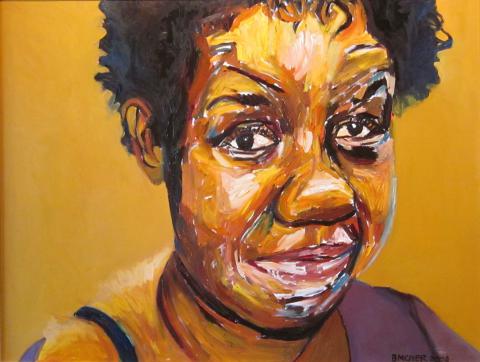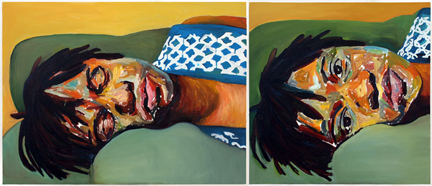Close Reading: Gwen I
By abby roseSeptember 30, 2014 - 21:20


Serendip is an independent site partnering with faculty at multiple colleges and universities around the world. Happy exploring!




I was drawn to Beverly McIver's portrait of her sister, Renee. She demonstrates how much she cares for her sister in the attention to detail and expression she conveys. McIver seems to have used oil paint in this portrait, which has allowed her to layer color on top of color -- the main appeal of the portrait.

World War I was one of the most horrifying wars the world has ever seen--trench warfare has been described as hellish muck, among other things. Unfortunately, one of the surprisingly common outcomes of trench warfare was injury to the face. A soldier would stick their head out of the trench, and lo--a shell explodes, and your face is gone, if you're lucky enough to survive. Those men that did survive were horribly disfigured. To help the healing process, many armies sponsored artists to create "portrait masks" for the afflicted veterans, a form of facial prosthetic, so they could regain some sense of a normal life.

In my search for a portrait featuring a visibly disabled subject, I came across this painting, by the artist Paul Fiore. I was particularly interested in this piece because it appears on Fiore’s blog with little information, other than the title “Amputee” and an explanation that he has not yet completed it. I hoped that a close reading of an unfinished product (particularly one painted by a man who, as far as I can tell from my research, does not have a visible disability) might give me some clues as to how Fiore intends to continue work on his painting.


Eyes Wide Open
This is a portrait done by Beverly McIver. I’m not sure, but it is possible that the woman in the portrait is her sister.
Things i noticed:

http://www.huffingtonpost.com/rachel-cohenrottenberg/doing-social-justice-thou_b_5476271.html
This is a great article on ableist language!

I feel that alot my reactions and feelings at Camphill were so intertwined with the events of last week that it is necessary to give a disclaimer that the emotional exhaustion defintely played a role in how I experienced the Village. I feel that the many surprises of last week were all a factor in how my observations of the facilities felt even more surprising. I already spoke in class about my struggles and surprises about Riva's visit and I felt almost even more out of my element at Camphill.

My privilege as an able-bodied person was demonstrated for me through the "Re-Presenting Disability" reading and Riva's commentary on how to get into the right mindset for making portraits of our future friends at Camp Hill. I had not realized that I might, without realizing it, portray my subject with an air of pity rather than as a person. As Garland-Thomson says, "bringing representations of people with disabilities into the public realm via traditional portraiture is an act of sociopolitical integration...as an appropriate member of the public sphere who is worthy of contemplation and commemoration" (24). I wish there were more representations of people who are disabled in popular culture like Rush's.

Visual images of our bodies immortalize us. They create points of reference that can be used to describe a person to somebody who didn’t know them. Whether is a photo album or a painting in a museum, there is a story behind every image, just waiting to be told. Much of what we know of history today stems from the art that was created centuries ago. By including disabled bodies in art, we are also including them in history.

During Riva's powerpoint she mentioned artists who portrayed issues with race, class, age, disability, as well as a size. This really struck me because I rarely hear fatphobia being talked about. I can not distinctly remember the image that she showed but, the concept of including size along with societies categories that other people really resonates with me. I think that within the classroom size discrimination is rarely talked about. The demonized word fat is compared to the words queer and crip. In recent years campaigns like Let's Move led by Michelle Obama have systamically ostracized children of various size. While Fat Acceptence movements (mostly done through social media) are constantly critiqued or ignored.